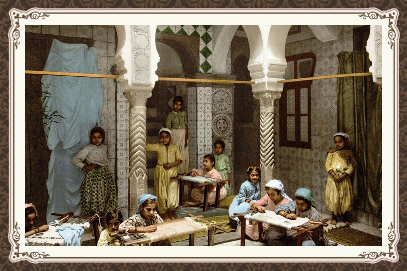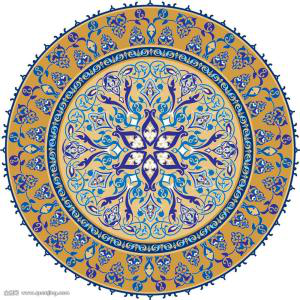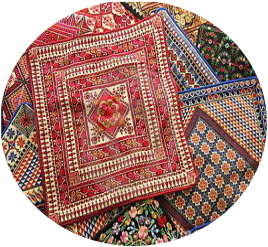Embroidery was an important art in the Medieval Islamic world. The 17th-century Turkish traveler Evliya Çelebi called it the "craft of the two hands". Because embroidery was a sign of high social status in Muslim societies, it became widely popular. In cities such as Damascus, Cairo and Istanbul, embroidery was visible on handkerchiefs, uniforms, flags, calligraphy, shoes, robes, tunics, horse trappings, slippers, sheaths, pouches, covers, and even on leather belts. Craftsmen embroidered items with gold and silver thread. Embroidery cottage industries, some employing over 800 people, grew to supply these items.
In the 16th century, in the reign of the Mughal Emperor Akbar, his chronicler Abu al-Fazl ibn Mubarak wrote in the famous Ain-i-Akbari: "His majesty (Akbar) pays much attention to various stuffs; hence Irani, Ottoman, and Mongolian articles of wear are in much abundance especially textiles embroidered in the patterns of Nakshi, Saadi, Chikhan, Ari, Zardozi, Wastli, Gota and Kohra. The imperial workshops in the towns of Lahore, Agra, Fatehpur and Ahmedabad turn out many masterpieces of workmanship in fabrics, and the figures and patterns, knots and variety of fashions which now prevail astonish even the most experienced travelers. Taste for fine material has since become general, and the drapery of embroidered fabrics used at feasts surpasses every description."
Hand Embroider Islamic Products Hand Embroider Islamic Products,Embroiderd Religious Element,Religious Element Embroidery,Nation Embroidery Haiyuan Aisha Handicrafts Company Limted , http://www.aishaembroidery.com
Wu Haiyan: The new engine of the creative industry will promote garment upgrading “In the transformation of the textile and clothing industry, the rise of the creative culture industry will bring improvements to the traditional industries.†Wu Haiyan, member of the National Committee of the Chinese People's Political Consultative Conference and vice president of the Design Institute of the China Academy of Art, interviewed by reporters Openly elaborated his own point of view. Wu Haiyan stated that Premier Wen Jiabao emphasized in his government work report that it is necessary to vigorously develop the modern service industry and that the national “Twelfth Five-Year Plan†has placed a great importance on improving cultural and creative industries. The textile and garment industry is at the end of the modern emerging industry. Many local governments are keen to develop the real estate industry, and do not pay much attention to the textile and clothing industry. For example, the silk and linen textile industries have been shrinking. There are thousands of years of history in textiles and clothing. The reason why silk and hemp has spread to today is its own reason. However, how to improve textile and clothing and achieve dialogue with the world is a question that we need to seriously consider. "In fact, the creative industry is the best opportunity to promote and transform the traditional apparel industry. In the past few years, we have developed a node roadmap for apparel design. It can be seen that at each node, such as design drawings and patterns, It can produce benefits. The traditional clothing industry can reflect value from spinning, weaving, and end products, and the creative industry can become a commodity at every node of the industry chain, realizing value." Wu Haiyan said.
Wu Haiyan revealed that in order to practice the creative industries and promote Chinese silk, she and her partner established an operation group called “Oriental Silk Kingdom†to explore the use of creative industries to upgrade the traditional silk industry. A batch of silk garments, cultural products, etc. have been designed and currently entered the Hangzhou star-rated hotel for sale. “This is also the implementation of the requirements set out in the government work report, discussing a combination of hospitals and enterprises, and jointly building new industries to upgrade the traditional industries. the way". She said that at the Beijing International Fashion Apparel Fair in March this year, he will display costume design samples and cooperate with Taobao to promote the development of creative industries.
Wang Yongzheng: Tailoring a good craftsmanship Culture and value When talking about corporate transformation and developing national apparel brands, Wang Yongzheng, member of the National Committee of the Chinese People's Political Consultative Conference and chairman of Tianjin Yongzheng Garment Co., Ltd., said that brands must have technical content, otherwise it is difficult to internationally On foothold. For example, he said that Tianjin Yongzheng Garment Co., Ltd. is relying on a strong independent brand and has won the favor of international buyers. “The price is set by us. Our foreign orders look at our faces.†He said, “Our brand is so beefy, relying on technical support and brand influence. Clothing is an art, and tailors are artists. Our The import of apparel fabrics and the export of products are not affected by the exchange rate, because we settle the settlement according to the exchange rate of the US dollar and the US dollar, which is more cost-effective for us. At present, Yongzheng has formed a virtuous circle.â€
Yongzheng Group was founded in the 80s of last century. They successfully adopted the dress concept of international successful people and the advanced fashion tailoring methods that can be enjoyed only by royalty, senior politicians and all walks of life. Domestic promotion has become a Chinese clothing custom company with great international influence and representativeness. Yongzheng tailor shop has been hailed by domestic and foreign counterparts as the “China's No. 1 tailor shopâ€, regularly conducting technical exchanges with the world's top hand sewing experts, and working closely with internationally renowned clothing brands for a long period of time. Walking in the forefront of domestic counterparts. The reporter found that the suit worn by Wang Yongzheng was a good fit. Wang Yongzheng told reporters that this suit was made of high-grade garments hand-cut and sew by British senior technicians using imported fabrics. It is understood that this suit will be sold at more than 10,000 yuan in China. "To export abroad, this suit will be sold for tens of thousands of dollars," Wang Yongzheng said. Comparing with international famous brands, this is the organic unity of value and brand's cultural connotation, and the power of the brand is also there.
Jin Jianhua: Local brand loyalty does not depend on the selection and training of the National Committee of the Chinese People's Political Consultative Conference (CPPCC) and General Manager Kim Jong Wah of Shanghai Pelowong Suit Company said in an interview with reporters that the further promotion of traditional Chinese brands is one of the proposals he has brought to the CPPCC session this year. He believes that the textile authority should strengthen the emphasis and support for traditional Chinese brands. Traditional clothing brands and handmade textiles are our valuable wealth and an important part of intangible cultural heritage. The protection of traditional brands should attract the attention of all parties.
“Brands are to be nurtured, companies need to have long-term development plans, goals, and pass on from one generation to the next. Now many of our companies are eager for instant success and they are fascinated overnight. Many brands in France have a history of hundreds of years. Their brand is built on A hundred years of business based on the ". Jin Jianhua said that to promote Chinese traditional brands, it is necessary to strengthen people's love and loyalty to Chinese brands. Cultivating brands requires the understanding and support of the society and the people. Jin Jianhua believes that brand names are not judged but produced in people's hearts. Therefore, clothing companies must devote their energies to brand building and must do their work.




The value chain has always been the "short board" of the apparel industry. How does Chinese clothing create higher value, achieve a qualitative leap in brand building, and finally stand tall in the world of clothing? With this question, the reporter interviewed members of the CPPCC of the fashion industry who participated in this year's ***** and asked them to express their opinions on the upgrading of the garment industry, the development of a new type of cultural and creative industry, the training of Chinese national brands and the clamour for international apparel.